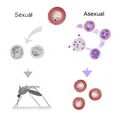Biology of the schizont
From haematologyetc.co.uk
Navigation
(click blue highlighted text to return to page)
Malaria main index
>Basic malaria biology
>>This page: Biology of the schizont
| What is the purpose of the schizont stage? |
Following the trophozoites stage, malaria parasites may enter one of two separate pathways:
(1) Sexual replication: male or female gametocytes are formed, these will be taken up by mosquitoes allowing the invasion of new hosts.
(2) Asexual replication: forms schizonts which will subsequently forming and release individual merozoites that invade further red cells.
| The schizont pathway and the role of merozoites: |
The stage begins with the first cycle of asexual replication forming a recognisable “schizont” then concludes when the individual “merozoites” are released to infect new erythrocytes.
The stage has specific features that have clinical and diagnostic relevance:
The stage begins with the first cycle of asexual division producing two chromatin masses (1), this is followed by further cycles of replication that in this case result in the formation of 8 daughter parasites (2&3). These daughter parasites mature and are then released into blood as separate “merozoites” (4&5). These very rapidly infect new red cells (so rapid that free merozoites will not usually be seen in blood).
Morphological relevence 1. The number of replication cycles differs between species. Some species undergo more cycles of replication, this means the typical number of merozoites formed differs between species with as few as 8 (in P.malariae) up to a possible 32 (in P.vivax). 2. This stage may not always take place in blood. In P.falciparum the schizont form adheres within the small vessels so is not seen in blood unless infection is very severe
Morphology of schizonts (link)
Relevance of schizonts to disease symptoms Development of parasites may be synchronous so that all schizonts mature and release their merozoites at the same time. The release of merozoites exposes the body to large amounts of free parasite antigens at that point in time. The result is a high fever and illness which may settle afterwards. Although rarely seen now, this may produce a pattern of remitting fever with a distinct periodicity depending on species: underlying the older descriptive terms tertian or quartan malaria.
